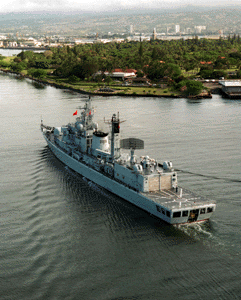 Powerful, lightweight, precision munitions now allow naval
commandos to destroy billion-dollar warships operating close to shore. In
past wars, commandos had to sneak up and attach explosives directly to
warships. The Italians were successful with such tactics
during World War II. They severely damaged two British battleships docked
in Alexandria. Even today, Italy maintains one of the world's only
naval commando units that trains to attack ships. Most naval commando units operate as marines and attack targets ashore. A little
known naval commando attack occurred in 1964 when a Vietnamese underwater
demolition team sunk the old escort carrier USS Card while she was in the Saigon River.
Powerful, lightweight, precision munitions now allow naval
commandos to destroy billion-dollar warships operating close to shore. In
past wars, commandos had to sneak up and attach explosives directly to
warships. The Italians were successful with such tactics
during World War II. They severely damaged two British battleships docked
in Alexandria. Even today, Italy maintains one of the world's only
naval commando units that trains to attack ships. Most naval commando units operate as marines and attack targets ashore. A little
known naval commando attack occurred in 1964 when a Vietnamese underwater
demolition team sunk the old escort carrier USS Card while she was in the Saigon River.
No Navy has grasped the value of anti-ship commandos in modern warfare. In previous wars, anti-ship weapons like 5-inch guns and torpedoes weighed thousands of pounds and could not be moved by small groups of men. However, modern, lightweight munitions allow small teams to sink ships from thousands of meters offshore. They can covertly land near strategic naval straits by boat, submarine, or aircraft to provide intelligence and attack warships. Although blue water navies prefer to avoid coastal areas there are many ocean straits where this is impossible. As a result, commandos can lie in wait on tiny islands, oil platforms, and waterways near ship homeports to employ precision munitions and sink modern warships. Naval commandos can also provide valuable intelligence similar to that of World War II coast watchers.
Naval commandos can also operate from fishing boats, pleasure yachts, and coastal barges. There are thousands of such craft afloat around the world today. The Germans used a similar tactic in World War II when they hid deck guns on merchant ships to operate as "surface raiders." When British warships pulled alongside to seize the ship, they were quickly sunk.
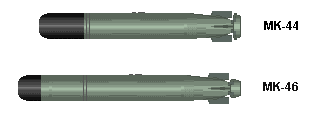 An ideal weapon is the MK-44 lightweight homing torpedo, which weighs 432 lbs and
has a range of 5000 meters. This was designed as an air-launched
anti-submarine torpedo, but could be reprogrammed to attack ships. This torpedo
can be carried in a plastic firing tube with inflatable pontoons
so it can float near shore until fired. Commandos could muscle these into position and launch them
to hit an
unsuspecting ship with its 75 lb high-explosive warhead below the waterline. Commandos
can
also use the newer MK-46 torpedo, which weighs 518 lbs and delivers a 98 lb
warhead. These torpedoes can also be air dropped from small
seaplanes or fired from fishing boats or pleasure craft outfitted with torpedo tubes.
Nations may install hidden torpedo launchers on offshore islands to fire larger torpedoes.
During wartime a submarine may visit to load tubes (below) and leave a couple sailors
behind to await targets of opportunity.
An ideal weapon is the MK-44 lightweight homing torpedo, which weighs 432 lbs and
has a range of 5000 meters. This was designed as an air-launched
anti-submarine torpedo, but could be reprogrammed to attack ships. This torpedo
can be carried in a plastic firing tube with inflatable pontoons
so it can float near shore until fired. Commandos could muscle these into position and launch them
to hit an
unsuspecting ship with its 75 lb high-explosive warhead below the waterline. Commandos
can
also use the newer MK-46 torpedo, which weighs 518 lbs and delivers a 98 lb
warhead. These torpedoes can also be air dropped from small
seaplanes or fired from fishing boats or pleasure craft outfitted with torpedo tubes.
Nations may install hidden torpedo launchers on offshore islands to fire larger torpedoes.
During wartime a submarine may visit to load tubes (below) and leave a couple sailors
behind to await targets of opportunity.
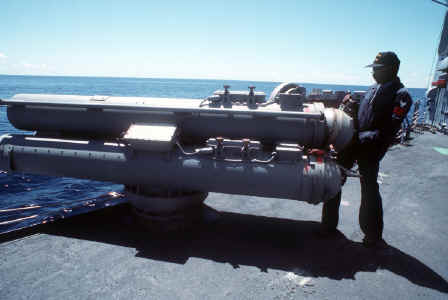 Another anti-ship weapon is the versatile
Hellfire laser-guided missile, which is now mounted on a tripod by the Norwegian
military. (below) This supersonic missile can
hit targets over 5000 meters away. Commandos can fire several missiles in a
few minutes and cause major damage, especially if they explode missiles stored
in ship box launchers. Commandos can also release sea mines in ship lanes and port
entrances. The explosion of just one mine may shut down all ship
activity until minesweepers can check the area. However, unarmed
minesweepers are easy targets for commandos as well so frigates must escort them, which become targets themselves.
Another anti-ship weapon is the versatile
Hellfire laser-guided missile, which is now mounted on a tripod by the Norwegian
military. (below) This supersonic missile can
hit targets over 5000 meters away. Commandos can fire several missiles in a
few minutes and cause major damage, especially if they explode missiles stored
in ship box launchers. Commandos can also release sea mines in ship lanes and port
entrances. The explosion of just one mine may shut down all ship
activity until minesweepers can check the area. However, unarmed
minesweepers are easy targets for commandos as well so frigates must escort them, which become targets themselves.
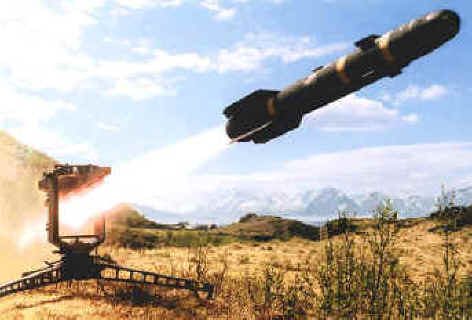 Warships rely
heavily on expensive helicopters to search for submarines and coastal
threats. Therefore, commando teams may carry shoulder-launched
anti-aircraft missiles like the Stinger system (below) and other such weaponry
also employed by Air Commandos. Large .50 caliber rifles like the Barrett M82A1
have a range of 1800 meters and are useful against helicopters and ships. A small bullet hole will not
sink a ship, but the semi-automatic Barrett can quickly punch dozens of holes in
a ship and cause
fires with incendiary rounds.
Warships rely
heavily on expensive helicopters to search for submarines and coastal
threats. Therefore, commando teams may carry shoulder-launched
anti-aircraft missiles like the Stinger system (below) and other such weaponry
also employed by Air Commandos. Large .50 caliber rifles like the Barrett M82A1
have a range of 1800 meters and are useful against helicopters and ships. A small bullet hole will not
sink a ship, but the semi-automatic Barrett can quickly punch dozens of holes in
a ship and cause
fires with incendiary rounds.
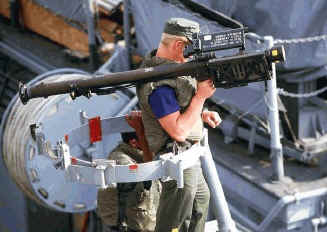 Ideally, naval commandos employ several weapons at
once from different locations. These "ship ambushes" may
involve up to a hundred men attacking several ships. In most cases, the
commandos scatter and hide after an ambush, especially when firing in neutral waterways. Inserting teams with heavy gear
takes practice and commandos must train in the employment of these
weapons. US Navy SEALS are ideal for this mission.
Ideally, naval commandos employ several weapons at
once from different locations. These "ship ambushes" may
involve up to a hundred men attacking several ships. In most cases, the
commandos scatter and hide after an ambush, especially when firing in neutral waterways. Inserting teams with heavy gear
takes practice and commandos must train in the employment of these
weapons. US Navy SEALS are ideal for this mission.
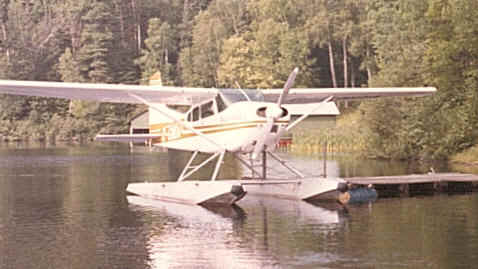 Small seaplanes are an ideal weapon for naval
commandos. They can drop off and resupply commandos or conduct attacks
themselves. Even tiny seaplanes can launch a Harpoon
missile or lightweight torpedo. These can hide along shore and dash out
and launch a weapon within a minute before any aircraft can intercept them or a
ship engage them. If the attack is dangerous, the pilot can land immediately
after launching his weapon and jump off and swim ashore. These cheap
seaplanes are expendable, cheaper than the missile they launch and cheaper than
anti-aircraft missiles fired at them.
Small seaplanes are an ideal weapon for naval
commandos. They can drop off and resupply commandos or conduct attacks
themselves. Even tiny seaplanes can launch a Harpoon
missile or lightweight torpedo. These can hide along shore and dash out
and launch a weapon within a minute before any aircraft can intercept them or a
ship engage them. If the attack is dangerous, the pilot can land immediately
after launching his weapon and jump off and swim ashore. These cheap
seaplanes are expendable, cheaper than the missile they launch and cheaper than
anti-aircraft missiles fired at them.
A submersible torpedo boat is ideal for naval commandos, like this one designed by North Korea and improved by Iran. It is pictured with a small coastal patrol boat. A modern destroyer is several times larger. More pictures and info found here:
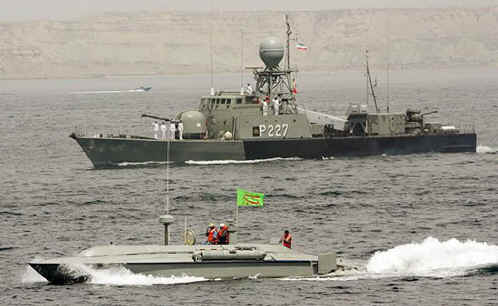 Specification
(
Specification
(
Length: 17m (56ft)
Beam: 3.3m (11ft)
Height: 3.5m (11.5)
Displacement: 22 tons
Speed: 40kt max surfaced, ~3kt submerged
Endurance: TBC -modest
Maximum Operating depth: 3m (10ft) with snorkel, 20m (66ft) max (estimate
based on I-SILC)
Personnel: 8 (4x crew, 1-2 escorts, 1-3 infiltrators)
Payload: 2 x 324mm (12.7") lightweight torpedoes. Possible storage of
MANPADS or RPGs and other crew weapons.
Powerplant: 2 x diesel engines (details TBC) plus two electric motors
Sensors: Basic Electro-optical (video), basic surface search / navigation radar,
echosounder
I'd prefer it to also have a pod of four supersonic Hellfire missiles or a 20mm gating gun. These could operate in "packs" with different weaponry like German U-boats in World War II. If they are discovered by a helicopter, they can quickly surface and shoot it down. These may lurk beneath a small fishing boat for cover, or venture out in rough weather beneath the surface to surprise a big ship. Keep in mind that a modern destroyer costs twenty times more than one of these boats. With modern self-guided torpedoes, these can sink billon dollar destroyers in coastal areas.
Another role for naval commandos is to serve as anti-naval commandos. After decades of plotting and executing attacks on ships they will be experts on how to hunt enemy naval commandos. If a friendly ship is ambushed and sunk, naval commandos may be dispatched to hunt down their contemporaries lurking near maritime chokepoints or harbor entrances. If a major war occurs in the Persian Gulf, the US Navy should expect numerous attacks by naval commandos and several will be embarrassingly successful.
©2015 www.G2mil.com